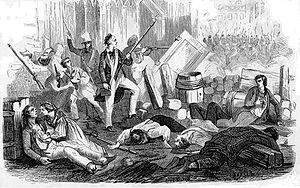June Rebellion
| June Rebellion | |||||||
|---|---|---|---|---|---|---|---|
 An 1870 illustration depicting the rebellion |
|||||||
|
|||||||
| Belligerents | |||||||
|
|
||||||
| Commanders and leaders | |||||||
|
|
|||||||
| Strength | |||||||
| 30,000 | 3,000 | ||||||
| Casualties and losses | |||||||
| 73 killed, 344 wounded | 93 killed, 291 wounded | ||||||
The June Rebellion or the Paris Uprising of 1832 (French: Insurrection républicaine à Paris en juin 1832), was an anti-monarchist insurrection of Parisian republicans on 5 and 6 June 1832.
The rebellion originated in an attempt of the republicans to reverse the establishment in 1830 of the July Monarchy of Louis-Philippe, shortly after the death of the king's powerful supporter, President of the Council Casimir Pierre Périer, on 16 May 1832. The death of Jean Maximilien Lamarque was a spark shortly before the revolutionaries rose to their barricades. The rebellion was the last outbreak of violence linked with the July Revolution of 1830.
Author Victor Hugo described the rebellion in his novel Les Misérables, and it figures largely in the stage musical and films based on the book.
In the 1830 July Revolution, the elected Chamber of Deputies had established a constitutional monarchy and replaced Charles X of the House of Bourbon by the more liberal Louis-Philippe. This angered republicans who saw one king replaced by another. By 1832 there were "simmering discontents, especially strong among republicans, who felt that they had spilled their blood on the 1830 barricades, only to have their revolution 'stolen' by a coterie of opportunists who managed to get Louis-Philippe crowned king".Bonapartists for their part lamented the loss of Napoleon's empire, and the Legitimists supported the deposed Bourbon dynasty and sought to place the man they regarded as true king, Charles's designated successor Henri, Count of Chambord, in power.
...
Wikipedia
